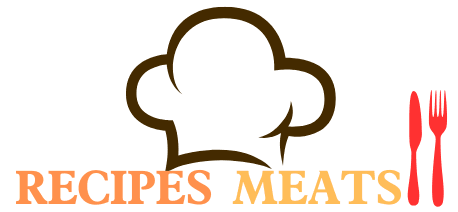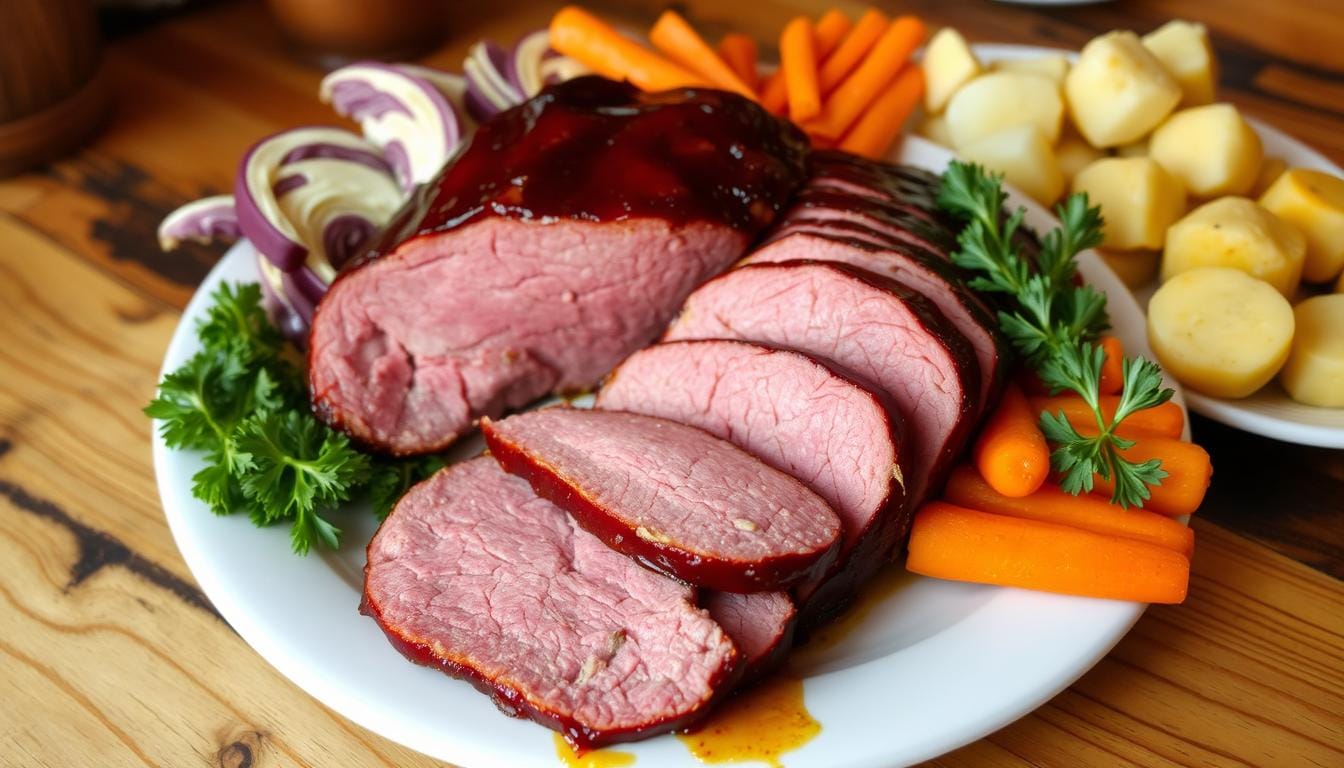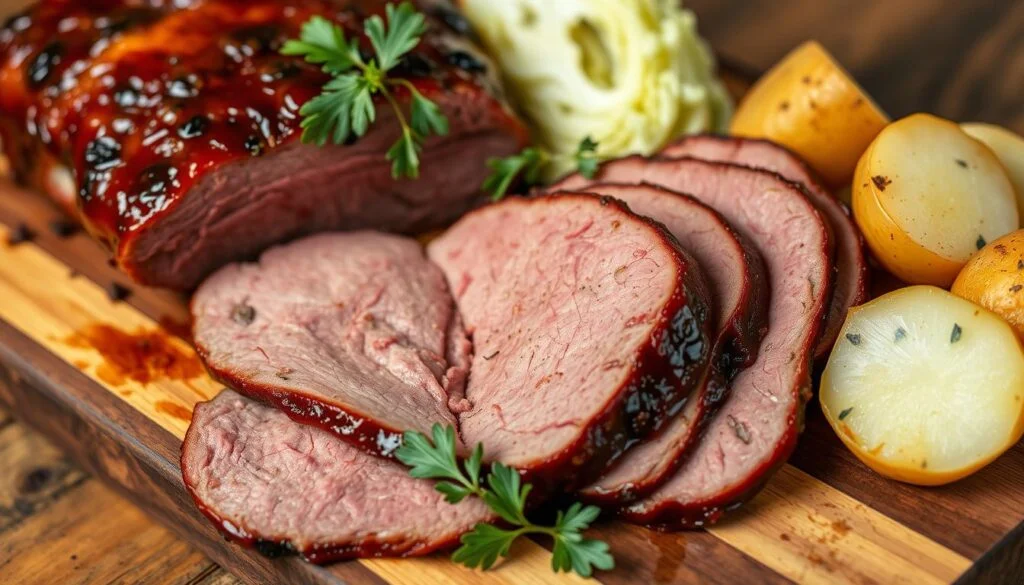
Corned beef – just the name stirs up thoughts of mouthwatering meals and hearty gatherings. But what exactly is corned beef? Is it just a tasty treat or does it have a rich history and cultural significance? In this exploration, we’ll dive deep into the origins, preparation, and the love affair between corned beef and the Irish-American community. So, grab a comfy seat and let’s dig into this classic dish!
Introduction to Corned Beef
To truly appreciate corned beef, we first need to understand what it is. At its core, corned beef is beef brisket that has been cured in a brine solution, typically with a mix of salt, sugar, and various spices. The term “corned” comes from the large grains of salt, called “corns,” that were historically used in the curing process. This method not only preserves the meat but also infuses it with a distinct flavor that’s hard to resist.Corned beef is often associated with St. Patrick’s Day and is a staple in many Irish-American households. But how did this cured meat become so integral to Irish culture, especially in the United States? Let’s take a stroll down memory lane.
The History of Corned Beef
Origins in Ireland
Believe it or not, corned beef isn’t a traditional Irish dish. In fact, it gained popularity in Ireland during the 17th century when the British began exporting beef from Irish farms. The Irish would cure the beef with salt to preserve it for long periods, especially before refrigeration was available. It was a practical solution for farmers and families who needed to store meat.Interestingly, the Irish would often consume pork, which was more readily available. The beef that was cured and exported was often meant for the wealthy classes. So, while corned beef has roots in Ireland, it’s not exactly the dish you’d find at every Irish table back in the day.
Evolution in America
Fast forward to the 19th century, when a wave of Irish immigrants made their way to America. These immigrants brought their culinary traditions with them, but they also had to adapt to their new surroundings. In America, they found that beef was more affordable than it was back home. Corned beef quickly became a popular and accessible dish among the Irish community.As St. Patrick’s Day celebrations began to flourish in the U.S., so did the association between corned beef and Irish culture. It became a symbol of Irish identity—a dish that reminded immigrants of home. Even though it wasn’t traditionally Irish, it became a beloved item on many dinner tables, especially when paired with cabbage.
“Corned beef and cabbage is not just a meal; it’s a tradition, a story of survival and adaptation.” — Unknown
What Is Corned Beef?
Now that we’ve covered the history, let’s get into the nitty-gritty of what corned beef actually is.
Definition and Ingredients
Corned beef is typically made from brisket, which comes from the chest of the cow. This cut of meat is tough, but when cured and cooked properly, it becomes incredibly tender and flavorful. The curing process involves soaking the beef in a brine solution, usually made from water, salt, sugar, and spices like peppercorns, mustard seeds, and bay leaves.But here’s a fun fact: you can also find corned beef made from other cuts of beef, such as round or chuck. The key is in the brining process, which transforms the meat into a delicious dish that’s perfect for sandwiches, stews, or just on its own with a side of potatoes.
How Corned Beef Is Made
Making corned beef at home can be a rewarding experience, and it’s simpler than you might think! Here’s a quick rundown of the process:
- Brining the Meat: Start with your chosen cut of beef. Prepare a brine solution with water, salt, sugar, and your favorite spices. You’ll want to submerge the meat in this mixture for several days, allowing it to soak up all those delicious flavors.
- Cooking: Once the meat has cured, it’s time to cook it. Traditionally, corned beef is simmered slowly in water or broth. This gentle cooking method helps to break down the tough fibers in the meat, resulting in a tender, juicy final product.
- Serving: After cooking, let the meat rest before slicing. Corned beef is often served with cabbage and potatoes, but it can also shine in sandwiches or as part of a hearty hash.
And there you have it! Corned beef is not just meat; it’s a culinary adventure that connects us to history, culture, and delicious flavors.
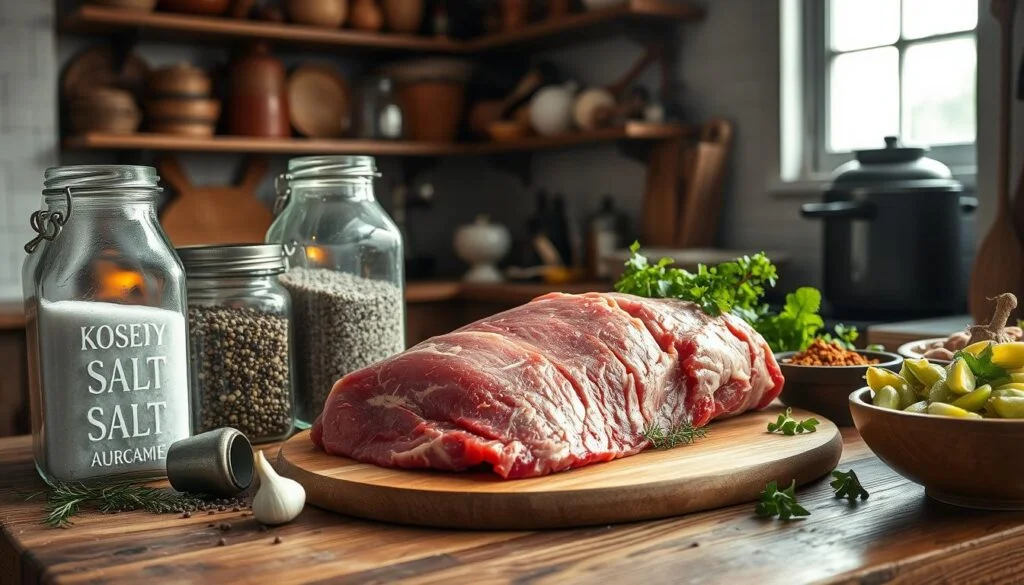
Corned Beef
Calories and Macronutrients
A typical serving of corned beef (about 3 ounces or 85 grams) provides a substantial amount of protein, along with significant amounts of fat, and sodium. Here’s a breakdown of what you can expect from a standard portion:
- Calories: Approximately 210-250 calories
- Protein: Around 20-22 grams
- Fat: About 15 grams (depending on the cut of beef used)
- Carbohydrates: Very low, typically around 1-2 grams
- Sodium: A significant amount, ranging from 800 to 1,200 milligrams, depending on how heavily the beef is cured.
Corned beef is considered a high-protein, high-fat food with a low carbohydrate count, making it a filling option for those on low-carb or high-protein diets. However, it’s also quite high in sodium, which is something to be mindful of, particularly for those on salt-restricted diets.
Health Considerations
While corned beef can be a tasty and protein-packed option, there are some health considerations due to its high salt content. The curing process involves salting the meat to preserve it, which leads to a high sodium concentration. Excessive sodium intake is linked to increased risk of high blood pressure, heart disease, and kidney problems.
In addition to its high salt content, corned beef is also typically high in saturated fats, especially if it comes from fattier cuts of beef. While moderate consumption is generally fine for healthy individuals, those with hypertension, heart conditions, or cholesterol concerns should consume corned beef sparingly.
For those looking to reduce the sodium intake, there are lower-sodium versions available, but even with these alternatives, it’s still important to balance the meal with plenty of vegetables and whole grains.
Variations of Corned Beef Around the World
Corned Beef in Irish Cuisine
In Ireland, the traditional preparation of corned beef differs slightly from the American version. Historically, corned beef was a luxury item in Ireland and was primarily produced for export, particularly to Britain and the United States. The Irish typically consumed it as part of a festive meal, particularly during special occasions or Christmas, rather than as a daily staple.
Corned Beef in American Cuisine
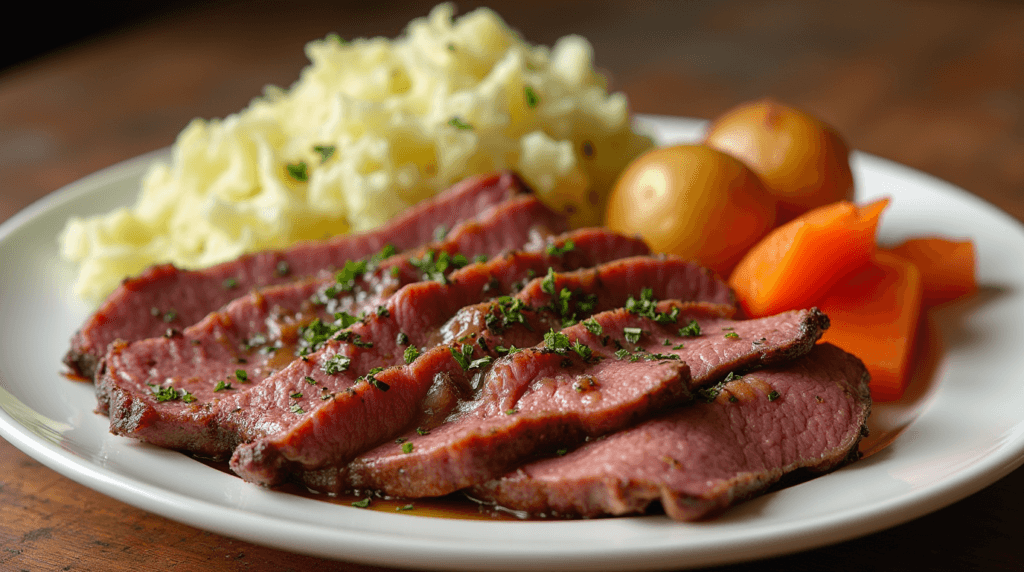
In the U.S., corned beef has taken on a variety of regional variations, each with its own flair:
- New England Corned Beef: In New England, corned beef is often enjoyed as part of a boiled dinner, where it is simmered with vegetables like cabbage, carrots, and potatoes. This version of corned beef tends to be fairly simple, relying on the rich flavors of the beef and the natural sweetness of the vegetables to create a hearty meal.
- Southern-Style Corned Beef: In the South, corned beef can be found in dishes such as corned beef and cabbage or corned beef hash. Some Southern variations introduce additional spices like paprika, garlic, and even hot sauce to enhance the flavor. The corned beef may also be paired with collard greens or cornbread for a more Southern-style twist.
- Jewish Delis: Although not directly related to the Irish-American tradition, corned beef has become a quintessential part of Jewish deli culture, particularly in cities like New York. In this context, corned beef is often served sliced thin and piled high on rye bread, frequently with mustard or pickles. This variation emphasizes the tender, salty flavor of the beef and has become iconic in American deli cuisine.
Certainly! Here’s a revised version of the text with a focus on reducing passive voice:
Thank you for the feedback! I’ll revise the text to reduce the passive voice even further, aiming for a more active sentence structure.
Thank you for pointing that out! I’ll adjust the heading levels to ensure consistency throughout the document. Here’s the corrected structure with the appropriate heading levels:
Frequently Asked Questions (FAQs)
Is Corned Beef the Same as Brisket?
Corned beef and brisket both come from the same cut, but they differ in preparation. Brisket is a tough cut that becomes tender with slow cooking. Corned beef is brisket that has been cured in a brine of salt and spices. This curing process gives it a distinct salty flavor and pink color. While brisket is often cooked without curing, corned beef requires this special process to achieve its unique taste.
Learn more about brisket and its uses from Beef It’s What’s For Dinner.
How Long Should Corned Beef Be Cooked?
The cooking time depends on the method and the size of the cut. Here are some general guidelines:
- Boiling: Boil for 2.5 to 3 hours for a 3-4 pound brisket, or until a fork easily pierces the meat.
- Slow Cooker: Cook on low heat for 6 to 8 hours.
- Oven-Baking: Bake at 325°F (163°C) for 3 to 4 hours. Cover the meat with foil to retain moisture.
Check the internal temperature. It should reach at least 190°F (88°C) for tenderness.
For more detailed cooking tips, visit The Spruce Eats.
Can Corned Beef Be Made Without Nitrates?
Yes, it’s possible to make this dish without nitrates, but it won’t have the same pink color or preservation qualities. Nitrates (or nitrites) help preserve the meat and prevent bacterial growth. You can use nitrate-free curing salts or natural substitutes, such as celery powder. Many butchers offer this nitrate-free option, but it may taste slightly different.
For more on nitrate-free curing, see The National Center for Home Food Preservation.
Can Corned Beef Be Frozen?
Yes, this dish can be frozen both before and after cooking. To store leftovers, wrap the corned beef tightly in plastic wrap or foil, and place it in an airtight container or freezer bag to prevent freezer burn. It will last 2 to 3 months. Thaw in the refrigerator overnight, and reheat by simmering, baking, or microwaving until hot.
Uncooked corned beef can also be frozen. Store it before cooking, and it will last up to 2 months. Be sure to check the best-before dates, as freezing can extend shelf life but doesn’t preserve the meat forever.
Find more on food storage at FDA’s Food Safety Website.
Conclusion
This iconic dish has become a staple in both Irish and American cuisine. It is well-known for its rich flavor and cultural significance. Originally from Ireland, it has grown to be an essential part of American celebrations, especially around St. Patrick’s Day. Whether served in a traditional boiled dinner or as part of a hearty sandwich, it remains a versatile and popular choice. This dish’s continued popularity showcases its connection to Irish-American heritage and its ability to unite people across generations.
